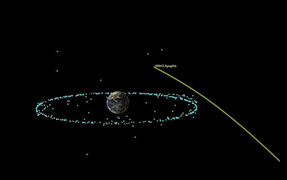The new network in space—and what it means for scientific observation

Fewer than 70 years since the first satellite launched into orbit, we’ve evolved into a society deeply dependent on space-based technology for the functioning of our global modern economy, and for running our daily lives.
This technology has also revolutionized the field of astronomy. NASA’s Hubble Space Telescope, Chandra X-ray Observatory, and the—most powerful yet—James Webb Space Telescope (JWST) have fundamentally changed our understanding of the Universe and our cosmic origins.
Recent trends in both commercial and national security space may open even more possibilities for scientific observations—specifically, in the realm of data sharing and networking on orbit. Advancing on-orbit networking capabilities, pushed forward today by the increasing demand for small satellites, promises to ease data bottlenecks and increase the efficiency of scientific instruments in space.
Small satellites and big potential
Many of our nation’s most critical missions in national security require robust satellites to serve as resilient nodes, able to withstand threats posed by modern adversaries in wartime. But other applications in space can afford a different risk profile per individual satellite, and can take fuller advantage of off-the-shelf components and less-robust requirements because their resiliency is somewhat inherent as part of a disaggregated architecture. This trend is known as proliferation in low-Earth orbit (LEO)—the model used by Starlink and OneWeb to provide commercial internet services.
Companies like Northrop Grumman are building dozens of satellites of this class for the Space Development Agency’s (SDA) Proliferated Warfighter Space Architecture (PWSA), a LEO constellation designed to provide high-speed data transport to troops serving around the globe.
Small satellites are not suitable for every mission. Many vital national security missions require larger and more complex satellites, and the same is true for astronomy. To detect the most faint, distant objects, we require large optics. The glass primary mirror of the National Aeronautics and Space Administration’s Hubble Space Telescope is 2.4 meters in diameter, almost double the size of most PWSA space vehicles. While the JWST beryllium mirror is far lighter, at 6.5-m diameter, its mass requires a large spacecraft bus.
The boom in small satellite production, however, has spurred tremendous advances and innovation in on-orbit networking. New techniques for data transfer and data sharing on orbit present opportunities for applications in astronomy, regardless of the orbit.
Early on in Northrop Grumman’s work for the PWSA—which will move enormous amounts of encrypted data around the world and use sensors for detecting and tracking advanced ballistic missile targets—we invested in demonstrating the core communications technology that enabled it: Spacecraft-hosted optical (laser) communications terminals built in conjunction with our Germany-based terminal provider, Mynaric.
We demonstrated that using the common data standard prescribed by the SDA we could cross-link two satellites on orbit. Last year, we demonstrated seamless communication between two terminals built by separate manufacturers using that same common data standard.
Eliminating bottlenecks
The same technology used to trade tracking and targeting data between small satellites could be applied to time-domain astronomy, for example, to maintain a fixed observation on a distant object.
Whether it’s a system of small satellites in LEO, or two independent large-scale observatories in high orbits, a common data standard allows satellites built by different manufacturers to talk to each other and creates opportunities for future networked missions across institutional and international borders, eliminating data bottlenecks and enabling shared ground- and space-network resources.
Today’s space observatories transmit their data directly to ground sites that come and go as Earth rotates and the observatories move across the sky. These systems use radio frequency communications and make use of ground sites with large antennas or domes that often service a single satellite at a time.
As a result, each space observatory has limited opportunities to transmit data, which substantially limits the amount of scientific data that can be transmitted back to Earth. In other words, some of our most valuable astronomical assets may be limited not by their ability to collect data, but by their ability to send it back to the ground.
For example, the Mars Express Mission took 10 years to map 90 percent of the planet’s surface (60 percent in high resolution), limited by the ability to record and send the data home. Similarly, the Mars Reconnaissance Orbiter (MRO), nearing 18 years in mission, has averaged just nine megabytes per day of returned data—a rate equivalent to less than one high resolution cell phone picture a day.
Increasing the use of optical communications can eliminate this bottleneck by both increasing the number of data connection points and by increasing the data rate of each connection. Furthermore, using optical communications would supercharge data transfer between our on-orbit and deep-space-exploring sensors and Earth.
Optical ground sites and space relays can be deployed at an ever-decreasing cost, allowing near-constant connectivity for future observatories. Optical communications use frequencies that are 100,000 times higher than standard radio frequency systems, permitting data links that exceed 100 Gbps. That is fast enough to transmit all 18 years of MRO data in just two hours.
While more data means more science, this game-changing increase in connectivity and data rate also opens new types of science where multiple observatories can interact and coordinate at never-before-seen levels. And with more emphasis on processing data on the edge—meaning, inside the system on orbit and not on the ground—two future observatories using a common data standard could cooperate in an observation, generate complimentary data, process that data on orbit, and send it back to the ground in a more efficient package that would further speed up data transfer back to Earth.
As industries continue to adapt to meet the demand for commercial and government missions, the scientific community will likely continue to discover new opportunities afforded by this evolving and increasingly accessible space domain.
Blake Bullock is vice president for Northrop Grumman’s communication systems business unit.



